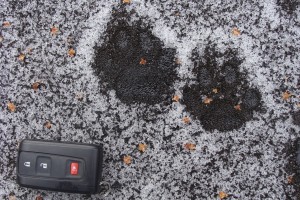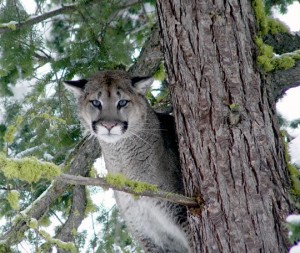Trail Cam: Bobcats at home
After tracking a local bobcat to it’s home in the cliffs, Director James McNaughton set up a trail camera in order to catch a glimpse of the daily life of these elusive animals. Check it out!
The American Crow – Communal Roosting
Birds do not weigh that much, their hollow bones and sleek, aerodynamic figures are optimized for a life in the sky. With that in mind, imagine a tree so dense with loud, dark-feathered fowl that at any moment its limbs are in danger of breaking under the weight. This tree, having lost its leaves for the winter has grown a new type of foliage in the last few hours as crows (Corvus brachyrhynchos ) pour in from all over the region to share the safety and warmth of a communal roost.
in from all over the region to share the safety and warmth of a communal roost.
Now imagine that this is only one tree amongst several dozen trees and that every single move you make is being carefully observed by thousands of pairs of eyes.
Last Wednesday the AIAO staff, along with friends and family, went on a reconnaissance mission to find such a place. Equipped with two-way radios, cell phones and video cameras, the search team consisted of three cars and about nine people – all of them scanning the skies for the first signs of this local migration.
Crows will often travel together in groups of 4-10 (commonly called “murders”) in order to increase their chances of finding food and spotting predators. Sometimes they also fly solo – like people, each animal will have it’s own preferences and personality. These individuals and small family groups are going to provide you with the first clues as to where your local roost is. There is not a lot of research as to why the crows gather in this way but it is theorized that they do so for both the benefits of shared body warmth as well as protection from predators. From a humans perspective, four thousand crows in one place can be both magical and highly intimidating. Crows will often harass larger birds of prey even when not in a large group so the wise owl would b e keeping a low profile during such an event.
From an open field or a high point such as a mountain or the top of a building you will be able see the first signs of gathering about two and a half hours before sunset. By triangulating the flight path of these smaller groups you can get a vague idea of where to start looking.
The chase started for our team when, while stationed behind a large hardware store in Holyoke, a group of about 50 crows started streaming over our heads, all headed for the same place. Small groups will congregate into larger groups and these multiple-family caravans will combine at Staging Areas (video) where they call out and wait for others to join them. A staging area will have somewhere in the area of hundreds of crows.
With the chase on, all three cars took off, stopping occasionally at graveyards, fields and high points to get a better view of the skies and to adjust their driving directions. The most challenging part of this part of the chase is avoiding dead ends and high-traffic areas. One wrong turn can leave you crow-less and direction-less with the lowering sun threatening to take away your view of the sky.
Finally, after about two hours we found ourselves under a canopy simply writhing with activity. Crows of all different species had come together in the thousands to what we thought was the final roosting area…
And then, at some unknown signal – they all flew away.
Ten more minutes of driving brought us to the final roosting area. Four thousand crows from all over the region would be a modest estimate of what we found here yet even in their large numbers they still kept their distance from us, parting their masses over our heads as we walked through their roost.
And by morning, they were gone.
For more information, check out: http://www.crows.net/roosts.html
Published by:
Christopher J. Poulin
Adventure In Adventure Out, Field Instructor
Nature Mystery Of the Week!
This weeks nature mystery was photographed last winter in the Quabbin reservoir. A new mystery will be posted next week along with this weeks answers – Good luck!
Some things to consider:
Who left this sign?
What part of the animal’s body were these marks made with?
What kind of tree are these marks on?
Eastern Cougars?
As a professional naturalist one of the most common questions people ask me is whether or not there are cougars in the Northeast. It seems like everyone and their grandmother has a story about the time they spotted a ‘giant long-tailed feline’. These stories are so common that they are often greeted with the same skepticism as the “big fish that got away” story.
“So what’s the deal?”
Well, what it comes down to is one big mess of miscommunication between the general public and the scientific community. The miscommunication comes from statements made in 2011 by the U.S. Fish and Wildlife Service declaring that the ‘Eastern Cougar’ had gone extinct. What is often not clear about this statement is that the term “Eastern Cougar” is the common name for the cougar subspecies: “Puma concolor couguar” which is often taken to mean “cougars living in the East”. This interpretation would be incorrect because despite its name, populations of this subspecies are more commonplace in the Western states.
Now, I am not calling your grandmother a liar by any means. There are many good reasons why individual cougars are showing up in New England and according to The Cougar Network, an organization dedicated to documenting and understanding the activity of this animal, there have been many confirmed cases of cougar presence in the region.
“Well, where do they come from?”
The most common explanation I have heard is that the animals we find in this part of the country are here because they have either escaped or been released from private collections. It is not uncommon for people to poach young animals and sell them on the black market to people with the land and the desire to keep them. This behavior is actually a huge concern of biologists and other professionals that study and protect endangered animals species. One of the dangers of raising a cougar in captivity is that when animals grow up reliant on humans they are bolder and less fearful of us and thus pose a greater potential danger to the human communities they live near.
“So, why does the government keep telling my grandmother that she didn’t see a cougar?”
Here is a summary of the U.S. Fish and Wildlife Service’s stance on the issue.
So, in conclusion, there is a body of empirically gathered evidence that clearly demonstrates cougar presence in New England. As far as we know these animals are very rare in this part of the country and there are no established breeding populations in the East.
Happy Adventuring!
Adventures in the Valley – Pudding stone caves.
Nestled amongst the craggy sandstone rock formations on the North-West side of Mt. Toby is perhaps one of the most enchanting hidden places in the Pioneer Valley…
The “Pudding Stone” cave, named for the conglomeration of small stones glued together by a sandstone mortar that make up this rock formation, is one of the few caves in the Valley that is actually large enough to walk through. If you are looking for adventure, this is the place to go.
Consisting of two main chambers connected by a twisting rocky hallway this cave is refuge to many local animals in both the summer and winter months. In the summer you’ll find (and smell) the porcupines that call this cave their home, evidenced by large piles of cashew-shaped scat and the occasional discarded quill. In the winter this cave is refuge for many hibernating insects as well as a small population of little brown bats.
Sign of porcupine living in and near this cave indicate that it has been in use by these animals for decades, at the very least. Exploring this section of Mt. Toby you will find many freshly cut hemlock and oak (depending on the time of year) twigs littering the ground. Many of the hemlocks that you find near a porcupine den with have a ‘bushy’ look to them as a result of annual trimmings from the powerful beaver-like teeth of this animal.
Small secluded caves like this are incredibly important to local bat species due to the introduction of ‘white nose fungus’, a European disease that is affecting bats all throughout the United States and Canada.
Also of note is the large and charismatic fissure that splits the ground a little further uphill from the caves themselves. The ground above the caves is covered with many smaller fissures which give this cave a very well lit, non-claustrophobic feel.
The Northernmost section of the cave opens up on a narrow, cliff-side path that leads around both sides of the rock formation. The main chamber is accessible through this entrance and is what makes this cave the hidden gem that it is. In the winter, if you are lucky, the combination of a cold Northern breeze and water dripping through the ceiling creates the most beautiful columns of ice which grow up from the floor in some of the most surreal and fantastic of ways. Reminiscent of crystal, these ice formations are sometimes over eight feet tall and shaped like something from a Dr. Seuss storybook. Glow sticks or colored flashlights make this place absolutely magical.
Happy exploring!
 Adventure In Adventure Out
Adventure In Adventure Out



